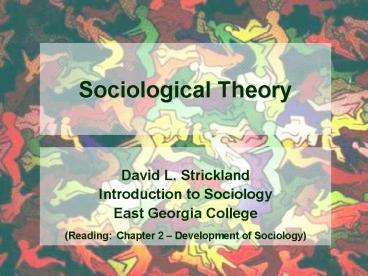Sociological Theory PowerPoint PPT Presentation
1 / 21
Title: Sociological Theory
1
Sociological Theory
- David L. Strickland
- Introduction to Sociology
- East Georgia College
- (Reading Chapter 2 Development of Sociology)
2
Paradigms
- Social theories
- can be tested using scientific methods.
- guides scientific methodology.
- is guided by scientific methodology.
- can be used to understand specific social
phenomenon.
3
Theoretical Perspectives
- Structural-Functional Perspectives
- Social-Conflict Perspectives
- Interactionist Perspectives
4
Using the Sociological Imagination to Examine
Society
- The sociological imagination allows us to
penetrate our social world and identify the links
between our personal biographies and larger
social forces to see that what is happening to
us immediately is a minute point at which our
personal lives and society intersect.
- How does the structure of society guide a
persons choices? - How does a persons relative level of power and
wealth in society impact their personal
experience? - How do social arrangements and social rules
influence the behavior of individuals and groups?
5
Structural-Functional Theory
- Functionalism views society as a set of
interrelated structures-or parts- with each
structure performing a function which is
important to the maintenance and stability of
society. Society is seen as existing in a state
of consensus and equilibrium.
6
Social System
- A social system emerges when the patterns of
interaction become institutionalized as a way to
address the needs of society.
7
Structure
- Structure is a habitual way of interacting that
is defined by the arrangement of statuses and
roles.
Dad
Child
Mom
Family
Family as Part of Society
8
Structural Functionalism
Social systems perform functions which keep
society stable.
9
Function
- Latent
- Functions
- Manifest
- Functions
Dysfunctions
10
Organicism
- Organ systems (Institutions) are linked to one
another. - Each part meets a need in order to maintain a
normal state of balance. - Change in one organ system (institution)
influences change in others.
11
Organicism
- Homeostatic system
- Interdependence
- Stability
- Near equilibrium
- Balance
12
Structural Functionalism
- Portrays society as unified entity of
interdependent components where each part of the
structure contributes to the maintenance and
stability of the whole by performing a function. - Consensus and cooperation is the glue that holds
society together. - Society is a homeostatic unit that exist in near
equilibrium.
13
Conflict Theory
Conflict theory assumes that life rarely runs
smoothly and conflict is a natural part of
social relationships. Conflict theory takes the
view that society is based on competition over
scarce resources.
Marx
This competition generally manifests itself in
struggles between dominant groups and subordinate
groups.
14
Who is on top?
- Various groups compete for limited resources.
Wealth, Power, Prestige Resources, Control,
Authority
Dominate Groups
Subordinate Groups
15
Conflict Theory
- Focuses upon explaining the mechanisms for social
change. - Views conflict as inherent in society as groups
compete for scarce resources, power, and
authority. - Gives attention to inequalities in society.
16
The Power Elite
- The country is ruled by the power elite, a groups
of individuals who because they occupy certain
institutional positions make decisions that have
national consequences. - They are the most powerful people in commerce,
politics, and the military.
C. Wright Mills
Conflict arises over power and authority rather
than just as a struggle between two classes.
17
Interactionism
- Interactionist theories are micro level
analysis of society that seek to explain how
people make sense of the world including how the
self concept is formed, how meaning is applied
to symbols, and how reality is socially
constructed.
18
Symbolic Interaction
- Symbolic interaction is the process through which
the use of symbols (language or gestures that
come to stand for something else) makes social
behavior possible. - Subjective meaning must be examined to understand
behavior. - Meaning can change.
19
Social Construction of Reality
- If things are perceived as real, they are real
in their consequences (Thomas Theorem)
20
Looking Glass Self
- We think of ourselves as we imagine how others
view us.
21
Conclusion
- There are three main paradigms in sociology
Functionalism Conflict Theory and
Interactionist Theories. - Each of them provide a unique viewpoint for
examining society, social phenomenon, and human
interactions.

